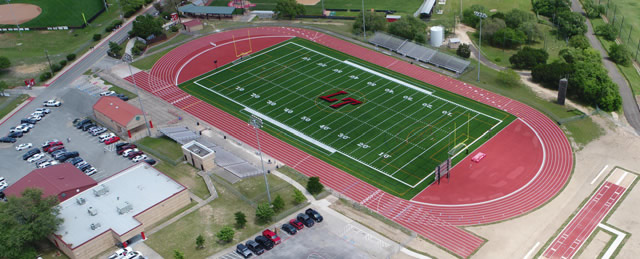Synthetic Turf That Wins for the Environment
It's important that fields be designed and constructed to not only protect athletes and budgets, but also the environment.
In 2017, CEI was hired to work with Lake Travis ISD in
Austin, Texas to design synthetic turf systems for four
separate schools, as well as improve their 400-meter tracks.
The schools — located in different city or unincorporated county
jurisdictions in Lakeway, Austin, Bee Cave and Travis County —
needed separate permits.

Each governing body had its own strict environmental standards.
As the permitting processes began, each jurisdiction raised
concerns whether heavy metals like lead and zinc would leach
into the water system from the styrene-butadiene rubber (SBR),
or black tire rubber granules, used as an infill in the turf system.
Each jurisdiction also ruled that synthetic turf is an impermeable
surface and that detention volume would be required.
As the school district’s budgets for these fields were not sufficient
to include new water detention and quality ponds, nor was it
enough to utilize more expensive infill materials that do not leach
heavy metals, our team was tasked to design a system that would
resolve permitting concerns while meeting the project budgets.
Our solution was a breathable, crushed limestone underdrain
system set on a geotextile fabric layer with a compacted, structural
base.
Our design for each field’s underdrain system utilized washed,
crushed limestone to provide underground detention in the air
void space of the stone. At the same time, the gradation of the
stone and its configuration with the storm water collection systems
was designed to maximize contact between the stone and the water
and thereby maximize water quality.
Field testing was conducted to demonstrate that the crushed
limestone had a void ratio above 45%, which was needed to
provide adequate detention volume for a 100-year storm beneath
the field. Studies from other industries such as mining were used
to demonstrate that crushed limestone is an effective means of
removing zinc and other heavy metals from water, with up to 90%
removal when designed to optimize contact time between the
stone and water.
By using this design, we successfully demonstrated that the
granular-infill synthetic turf systems are self-sufficient and
self-treating systems that do not require separate water detention
and water quality ponds even when SBR rubber is used as an infill
media. After a 14-month permitting process, the governing bodies
had each accepted the design and granted permits and each of
these fields are presently constructed.
This is a significant precedent. Over the past decade, multiple
studies have been conducted to determine if SBR rubber infill in
turf poses an environmental threat. Each study has concluded
that this type of turf does leach lead (within EPA limits) and zinc
(sometimes above EPA limits) to storm water. However, none of
these studies make definitive conclusions regarding the environmental
threat, but rather only conclude that more research is needed.
Thus, successful permitting for these projects in the Austin,
Texas area is significant because of the decisions made after such
extensive review processes.
Many schools, universities and private sports entities have
converted grass fields to granular-infill synthetic turf and many
more are in the process. This product is proven in performance
and long-term cost effectiveness, and so this trend will continue.
As this happens, it is important that fields be designed and
constructed to not only protect athletes and budgets, but also the
environment. We have shown that this can be done and, if properly
designed, the turf system will not only maintain water quality, but
it will improve it.
The environmental threat of zinc and lead in storm runoff from
synthetic turf is real but well-maintained grass fields pose threats
to the environment as well. Grass fields harm the environment by
means of the pesticides and fertilizers they require. Storm runoff
from a newly fertilized grass field can contain levels of nitrogen,
phosphorus and potassium that do not meet typical sewer treatment
water standards. Runoff from granular-infill turf fields do
not have these pollutants present. A properly designed turf field
can be a winner for owners, athletes and the environment.
This article originally appeared in the School Planning & Management October 2019 issue of Spaces4Learning.
About the Author
Jeff Bresee, Sports Division Manager at CEI started designing synthetic turf fields in 2001 and has developed stringent performance design standards
that provide high quality, competitively priced synthetic turf fields. Jeff has designed over 150 turf fields and over 300 sports facilities across multiple
school districts. He can be reached at 817-507-8305 or at [email protected].